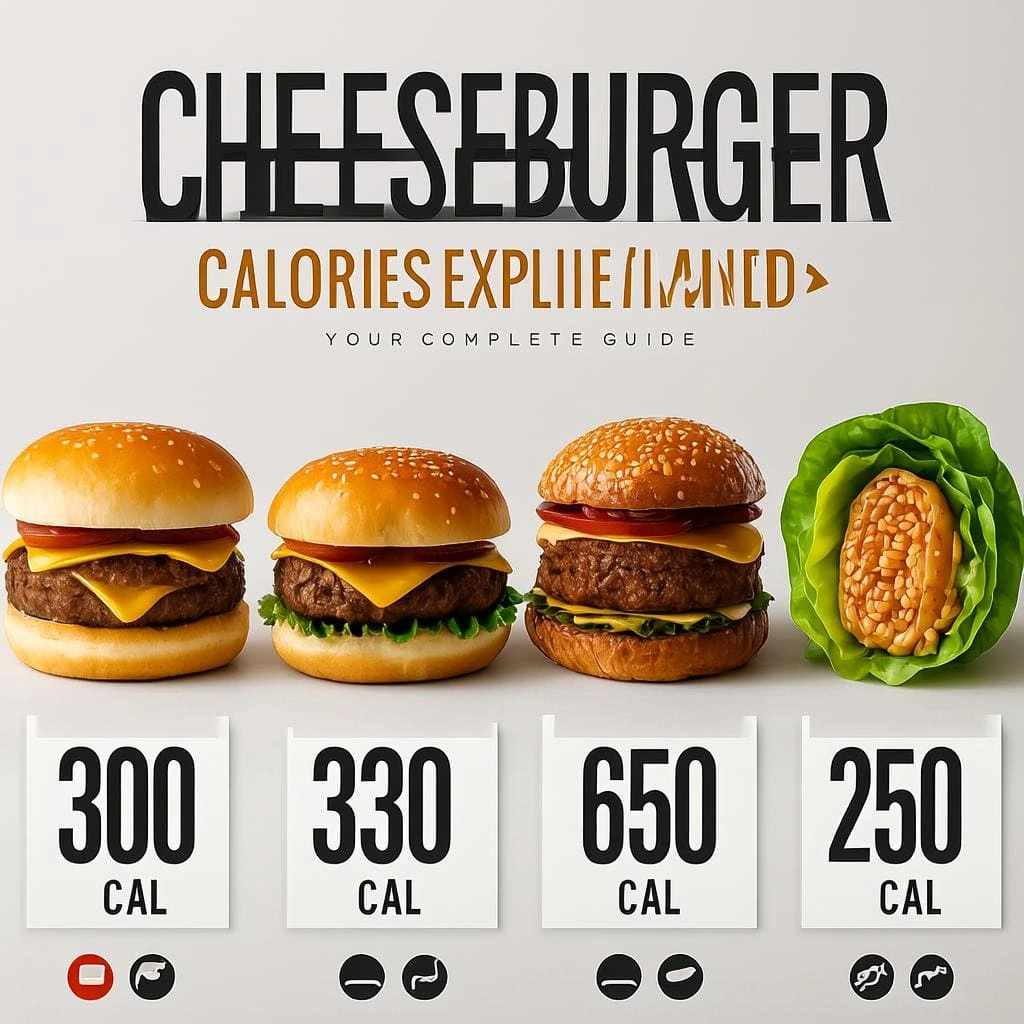
Cheeseburger Calories Explained
Whether you’re counting calories, trying to maintain a balanced diet, or simply curious about what’s in your favorite comfort food, understanding cheeseburger nutrition doesn’t have to be complicated. In this comprehensive guide, I’ll break down everything from fast-food favorites to homemade creations, giving you the knowledge to enjoy your burgers while staying aligned with your health goals.
Why Cheeseburger Calories Matter More Than You Think
As a chef who’s spent decades perfecting burger recipes, I’ve learned that understanding cheeseburger calories isn’t just about numbers on a scale—it’s about making informed choices that let you enjoy life’s delicious moments without guilt.
The average cheeseburger contains anywhere from 300 to 800+ calories, but that range tells only part of the story. The real magic happens when you understand what contributes to those calories and how you can make tweaks that align with your lifestyle.
The Complete Calorie Breakdown
Let me walk you through what makes up those calories in a typical cheeseburger:
Beef Patty (4 oz, 85% lean): 193 calories
- This is your protein powerhouse, delivering essential amino acids and B-vitamins
Cheese Slice (American): 50-80 calories
- Adds calcium and flavor, but also saturated fat
Hamburger Bun: 117-150 calories
- Your primary carbohydrate source, providing quick energy
Condiments & Toppings: 20-100+ calories
- Where customization can make or break your calorie goals
Fast Food Cheeseburger Calories: The Complete Comparison
After analyzing nutritional data from major chains, here’s what you’re looking at when you hit the drive-through:
Popular Chain Breakdown
McDonald’s Cheeseburger: 300 calories
- Fat: 12g | Carbs: 33g | Protein: 15g
- One of the smaller options, perfect for lighter meals
McDonald’s Double Cheeseburger: 440 calories
- The extra cheese and patty significantly boost the calorie count
Fast Food Large Patty with Condiments: 480 calories
- 33% carbs, 45% fat, and 22% protein macronutrient distribution
P. Terry’s Burger Stand Cheeseburger: 464 calories, 25.5 grams of fat, and 26 grams of protein
- Higher protein content due to quality sourcing
What These Numbers Really Mean
As someone who’s created countless burger variations, I can tell you that the calorie variance between chains often comes down to:
- Patty size and fat content
- Cheese type and quantity
- Bun size and composition
- Condiment portions
Want to track your intake more precisely? Check out our calorie calculator to see how different burgers fit into your daily goals.
Homemade vs. Fast Food: The Calorie Truth
Here’s where my chef expertise really shines. A homemade cheeseburger made with 1/4 pound of 85% lean ground beef (193 calories), regular hamburger bun (117 calories), and American cheese slice (50 calories) totals 330 calories.
Why Homemade Often Wins
Control Over Ingredients: You choose the meat quality, bun type, and portion sizes Fresher Components: Fresh ingredients typically mean fewer calories and better nutrition Customization Freedom: Easy to swap ingredients for lower-calorie alternatives
The Restaurant Reality
Restaurant and fast-food cheeseburgers often pack more calories due to:
- Larger portion sizes
- Higher-fat meat blends
- Generous condiment applications
- Processed ingredients with added sugars and preservatives
Craving a restaurant-style burger at home? Try our build-your-own burger guide for delicious results with better nutrition control.
Understanding Cheeseburger Nutrition Beyond Calories
Complete Nutritional Profile
A typical restaurant cheeseburger provides:
Macronutrients:
- Protein: 20-30g (muscle building and satiety)
- Carbohydrates: 30-45g (energy for your body and brain)
- Fat: 15-35g (essential fatty acids and vitamin absorption)
Micronutrients:
- Iron: 15-25% DV (oxygen transport)
- Zinc: 20-35% DV (immune function)
- B-Vitamins: 10-30% DV (energy metabolism)
- Calcium: 10-20% DV (bone health)
The Sodium Consideration
Most cheeseburgers contain 600-1200mg of sodium—that’s 25-50% of your daily limit. This is crucial for those monitoring blood pressure or heart health.
Smart Strategies to Reduce Cheeseburger Calories
After three decades in the kitchen, here are my top techniques for enjoying burgers while managing calories:
At Restaurants and Fast Food
Order Modifications:
- Request no mayo (saves 90-100 calories)
- Ask for extra lettuce and tomato (adds nutrients, minimal calories)
- Choose mustard over mayo-based sauces
- Consider removing the top bun (saves 60-75 calories)
Portion Control Tactics:
- Share a larger burger with a friend
- Order a kids’ size when available
- Pair with a side salad instead of fries
Homemade Calorie-Cutting Techniques
Leaner Meat Choices:
- 93% lean ground beef (saves 40-50 calories per 4oz)
- Ground turkey (saves 20-30 calories per 4oz)
- Plant-based patties (varies, but often 200-300 calories total)
Bun Alternatives:
- Large portobello mushroom caps (saves 100+ calories)
- Lettuce wraps (saves 110+ calories)
- Whole grain thin buns (saves 30-50 calories)
Cheese Modifications:
- Reduced-fat cheese (saves 20-30 calories)
- Stronger flavored cheese in smaller amounts
- Nutritional yeast for a cheesy flavor (plant-based option)
Looking for lighter alternatives? Our turkey burger guide offers delicious lower-calorie options.
The Ultimate Cheeseburger Calorie Calculator
DIY Calorie Counting
Here’s my chef’s formula for calculating any cheeseburger’s calories:
Base Components:
- Beef patty (per oz): ~48-55 calories
- Bun: 110-150 calories
- Cheese slice: 50-80 calories
Common Add-ons:
- Mayo (1 tbsp): 94 calories
- Ketchup (1 tbsp): 19 calories
- Mustard (1 tsp): 3 calories
- Bacon (1 strip): 43 calories
- Avocado (1/4 medium): 60 calories
Quick Reference Chart
| Burger Type | Calories | Protein | Fat | Carbs |
|---|---|---|---|---|
| Fast Food Basic | 300-400 | 15-20g | 12-20g | 30-35g |
| Restaurant Regular | 450-650 | 25-35g | 20-35g | 35-45g |
| Gourmet/Large | 600-900+ | 30-45g | 35-55g | 40-60g |
| Homemade Light | 250-350 | 20-25g | 10-18g | 25-35g |
Enjoying this post? Make sure to follow us for more tasty content, cooking tips, and foodie updates!
We’d love to have you join our food-loving community!
Making Cheeseburgers Fit Your Diet Goals
For Weight Management
Calorie-Conscious Approach:
- Aim for 300-400 calorie burgers
- Focus on protein content (aim for 20g+)
- Balance with lower-calorie meals throughout the day
Meal Timing:
- Enjoy as a post-workout meal to utilize the protein
- Pair with a morning workout if having for lunch
- Consider as your largest meal of the day
For Muscle Building
Protein-Focused Strategy:
- Choose burgers with 25g+ protein
- Add an extra patty instead of extra cheese
- Pair with sweet potato fries for healthy carbs
For Heart Health
Sodium and Fat Management:
- Choose leaner meats (90%+ lean)
- Limit processed cheese
- Load up on vegetables
- Choose whole grain buns when possible
Need help finding healthier burger options near you? Check out our burger places guide for nutritious choices in your area.
Global Cheeseburger Variations and Their Calories
American Classic
- Calories: 400-500
- Features: American cheese, lettuce, tomato, onion, mayo
British Pub Style
- Calories: 500-650
- Features: Aged cheddar, bacon, HP sauce, thick-cut chips
Australian Beetroot Burger
- Calories: 450-550
- Features: Beetroot, pineapple, fried egg, cheese
Canadian Style
- Calories: 400-500
- Features: Back bacon, maple glaze, Canadian cheddar
The Science Behind Cheeseburger Satisfaction
Why We Crave Them
Umami Factor: The combination of beef and cheese creates a powerful umami (savory) flavor that triggers satisfaction signals in our brain.
Texture Contrast: The interplay between soft bun, juicy meat, melted cheese, and crisp vegetables provides textural satisfaction.
Fat and Protein Combination: This macro pairing promotes satiety and triggers pleasure responses.
Making Them More Satisfying
Mindful Eating Techniques:
- Eat slowly to allow satiety signals to register
- Focus on flavors and textures
- Put the burger down between bites
Nutritional Optimization:
- Add fiber through vegetable toppings
- Include healthy fats (avocado)
- Choose whole grain buns for sustained energy
Common Cheeseburger Calorie Myths Debunked
Myth 1: “All Cheeseburgers Are Diet Killers”
Reality: A 300-calorie cheeseburger can fit into most balanced diets when portion-controlled and balanced with other meals.
Myth 2: “Homemade Is Always Lower Calorie”
Reality: Homemade burgers can exceed 800 calories if made with high-fat meat, large portions, and generous toppings.
Myth 3: “The Bun Has the Most Calories”
Reality: In most cheeseburgers, the meat patty contributes the highest calorie count, followed by added fats from cheese and condiments.
Myth 4: “Removing Cheese Saves Significant Calories”
Reality: While removing cheese saves 50-80 calories, condiments like mayo often contribute more calories per serving.
Creating Your Perfect Lower-Calorie Cheeseburger
Khalid’s Signature Light Cheeseburger Recipe
Ingredients (Makes 4 servings):
- 1 lb 93% lean ground beef
- 4 whole wheat slider buns (or large lettuce leaves)
- 4 slices reduced-fat sharp cheddar
- 4 thick tomato slices
- 4 leaves butter lettuce
- 2 tbsp Dijon mustard
- 1 medium onion, sliced thin
- Salt and pepper to taste
Instructions:
- Season beef and form into 4 patties
- Grill or pan-cook for 4-5 minutes per side
- Add cheese in final minute to melt
- Toast buns lightly
- Assemble with vegetables and mustard
Nutritional Info Per Serving:
- Calories: 285
- Protein: 28g
- Fat: 12g
- Carbs: 18g
Want more delicious burger recipes? Browse our complete cheeseburger recipe collection for endless inspiration.
Visual Guide to Portion Sizes
Understanding Serving Sizes
Meat Patty Visual Cues:
- 2 oz patty = size of a small computer mouse
- 4 oz patty = size of a deck of cards
- 6 oz patty = size of two decks of cards
Bun Size Indicators:
- Small: 3-inch diameter
- Regular: 4-inch diameter
- Large: 5+ inch diameter
Cheese Portion Guide:
- 1 slice = 1 oz = size of your thumb
- 2 slices = doubles the cheese calories
Quick Takeaways: Key Points to Remember
• Average cheeseburger calories range from 300-800+, with homemade versions typically offering better control
• Fast food options like McDonald’s basic cheeseburger (300 calories) can fit into balanced diets when consumed mindfully
• The meat patty typically contributes the most calories, followed by the bun and added fats
• Simple modifications like choosing lean meat, reducing condiments, and adding vegetables can significantly reduce calories while maintaining satisfaction
• Protein content (20-30g) makes cheeseburgers surprisingly filling, helping with portion control for subsequent meals
• Homemade versions allow complete control over ingredients and portions, often resulting in better nutrition profiles
• Context matters more than individual calorie counts—how the burger fits into your overall daily intake and activity level
Frequently Asked Questions
How many calories are in a typical cheeseburger?
A standard cheeseburger contains 319 calories, though this varies significantly based on size, ingredients, and preparation method. Fast food versions range from 300-500 calories, while restaurant burgers can exceed 600-800 calories.
What’s the difference in calories between homemade and fast food cheeseburgers?
Homemade cheeseburgers typically contain 250-400 calories when made with lean meat and controlled portions, while fast food versions range from 300-600+ calories due to larger portions, higher-fat meat, and generous condiments.
Which part of a cheeseburger has the most calories?
The beef patty usually contributes the most calories (150-300+ depending on size and fat content), followed by the bun (110-150 calories), then cheese and condiments (50-150+ calories combined).
Can cheeseburgers fit into a weight loss diet?
Yes, when properly portioned and balanced with other meals. A 300-400 calorie cheeseburger can fit into most weight loss plans, especially when paired with vegetables and consumed as part of an active lifestyle.
How can I reduce the calories in my cheeseburger?
Choose lean meat (93% lean), use mustard instead of mayo, add extra vegetables, consider removing the top bun, opt for reduced-fat cheese, and control portion sizes. These modifications can save 100-200 calories per burger.
Ready to explore more burger wisdom? Check out our comparison of Burger King chicken sandwich calories or discover amazing burger spots in your area with our local burger finder.
